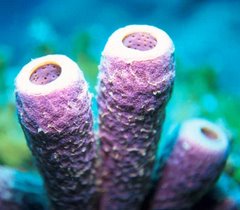Callyspongia vaginalis
The tube sponge is one of the most common varietes of sea sponge found on the reef. Tube sponges are distinguishable by its long tube-shaped growths. These sea sponges range from purple to blue, gray and gray-green in colour. Tube sponges are one of the few reef invertebrates that are blue in colour.

VASE SPONGE
Ircinia campana
Vase Sponges are a common species typically found in the Caribbean off the east coast of Florida. These sea sponges have a large bell shaped and a deep central cavity. Vase sponges can grow up to 2 feet wide and 3 feet high. They range in colour from purple to red and brown, and are known to make their homes on rocks near the sandy bottom of the ocean.
YELLOW SPONGE
Cleona celata
This poriferan is normally a small species commonly found throughout the Pacific coastal waters of the United States. Yellow sponges can be found growing in small colonies and range in colour from orange to bright yellow. This sea sponge can most often be found encrusting rocks on the reef face.

RED TREE SPONGE
Haliclona compressa
This bright red sponge species is very common throughout the Caribbean Sea. Red Tree Sponges typically grow to be about 8 inches tall. These sea sponges are realtively easy to take care of and keep in a home aquarium environment with a moderate water flow and dim light.
COMMON SEA SQUIRT
Didemnum molle
This species of sea squirt is very common on the reef, and is usually found in deep water. These sea sponges can be found encrusting the rocks in large colonies, and are known to have a leathery baglike body with a white and gray of brown spotted exterior, and a bright green interior.

PAINTED TURNICATE
Clavelina Picta
Tunicates are very similar to sea squirts. Like most sea sponges, they take water in through the osculum, filter out the nutrients, then expel the water through another opening. Painted turnicates are approximately ¾ inches long and usually grow in colonies. They vary in colours such as translucent red, purple and yellow.



2 comments:
worth reading
Actually, Tunicates (NOT "turnicates") are not sponges. They belong to the phylum Chordata (the same as the Vertebrates).
Post a Comment